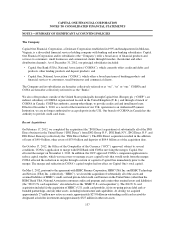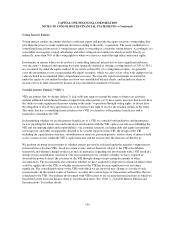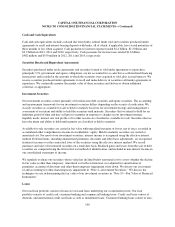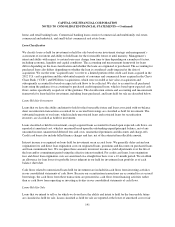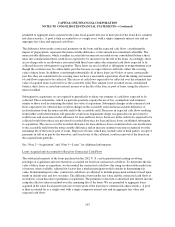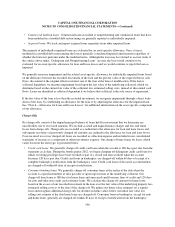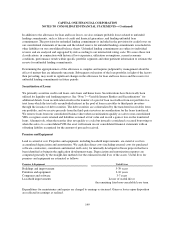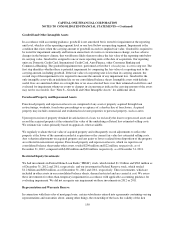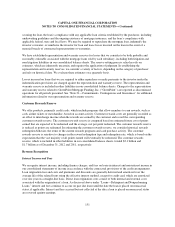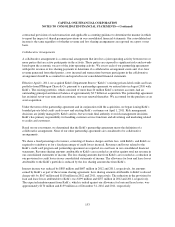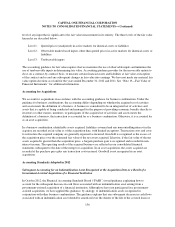Capital One 2012 Annual Report Download - page 166
Download and view the complete annual report
Please find page 166 of the 2012 Capital One annual report below. You can navigate through the pages in the report by either clicking on the pages listed below, or by using the keyword search tool below to find specific information within the annual report.CAPITAL ONE FINANCIAL CORPORATION
NOTES TO CONSOLIDATED FINANCIAL STATEMENTS—(Continued)
court. Auto and home loans in bankruptcy are charged-off in the period that the loan is both 60 days or more
past due and 60 days or more past the bankruptcy notification date or in the period the loan becomes
120 days past due for auto loans and 180 days past due for home loans regardless of the bankruptcy
notification date. Consumer loans of deceased account holders are charged-off within 60 days of receipt of
notification.
•Commercial banking loans: We charge-off commercial loans in the period we determine that the unpaid
principal loan amounts are uncollectible.
•Acquired loans: We do not record charge-offs on acquired loans that are performing in accordance with or
better than our expectations as of the date of acquisition, as the fair values of these loans already reflect a
credit component. We record charge-offs on impaired loans only if actual losses exceed estimated losses
incorporated into the fair value recorded at acquisition.
Allowance for Loan and Lease Losses
We maintain an allowance for loan and lease losses (“the allowance”) that represents management’s best
estimate of incurred loan and lease losses inherent in our held-for-investment portfolio as of each balance sheet
date. We do not maintain an allowance for held-for-sale loans or acquired loans, which includes purchased
credit-impaired loans, accounted for based upon expected cash flows that are performing in accordance with or
better than our expectations, as the fair value of these loans recorded at acquisition takes into consideration future
credit losses expected to be incurred. The allowance is increased through the provision for credit losses and
reduced by net charge-offs. The provision for credit losses, which is charged to earnings, reflects credit losses we
believe have been incurred and will eventually be reflected over time in our charge-offs. Charge-offs of
uncollectible amounts are deducted from the allowance and subsequent recoveries are added back.
Management performs a quarterly analysis of our loan portfolio to determine if impairment has occurred and to
assess the adequacy of the allowance based on historical and current trends and other factors affecting credit
losses. We apply documented systematic methodologies to separately calculate the allowance for our consumer
loan and commercial loan portfolios and for loans within each of these portfolios that we identify as individually
impaired. Our allowance for loan and lease losses consists of three components that are allocated to cover the
estimated probable losses in each loan portfolio based on the results of our detailed review and loan impairment
assessment process: (1) a component for loans collectively evaluated for impairment; (2) an asset-specific
component for individually impaired loans; and (3) a component related to acquired loans that have experienced
significant decreases in expected cash flows subsequent to acquisition. Each of our allowance components is
supplemented by an amount that represents management’s qualitative judgment of the imprecision and risks
inherent in the processes and assumptions used in establishing the allowance. Management’s judgment involves
an assessment of subjective factors, such as process risk, modeling assumption and adjustment risks and probable
internal and external events that will likely impact losses.
Our consumer loan portfolio consists of smaller-balance, homogeneous loans, divided into four primary portfolio
segments: credit card loans, auto loans, residential home loans and retail banking loans. Each of these portfolios
is further divided by our business units into pools based on common risk characteristics, such as origination year,
contract type, interest rate and geography, which are collectively evaluated for impairment. The commercial loan
portfolio is primarily composed of larger-balance, non-homogeneous loans. These loans are subject to individual
reviews that result in internal risk ratings. In assessing the risk rating of a particular loan, among the factors we
consider are the financial condition of the borrower, geography, collateral performance, historical loss
experience, and industry-specific information that management believes is relevant in determining the occurrence
of a loss event and measuring impairment. These factors are based on an evaluation of historical and current
information, and involve subjective assessment and interpretation. Emphasizing one factor over another or
considering additional factors could impact the risk rating assigned to that loan.
147


